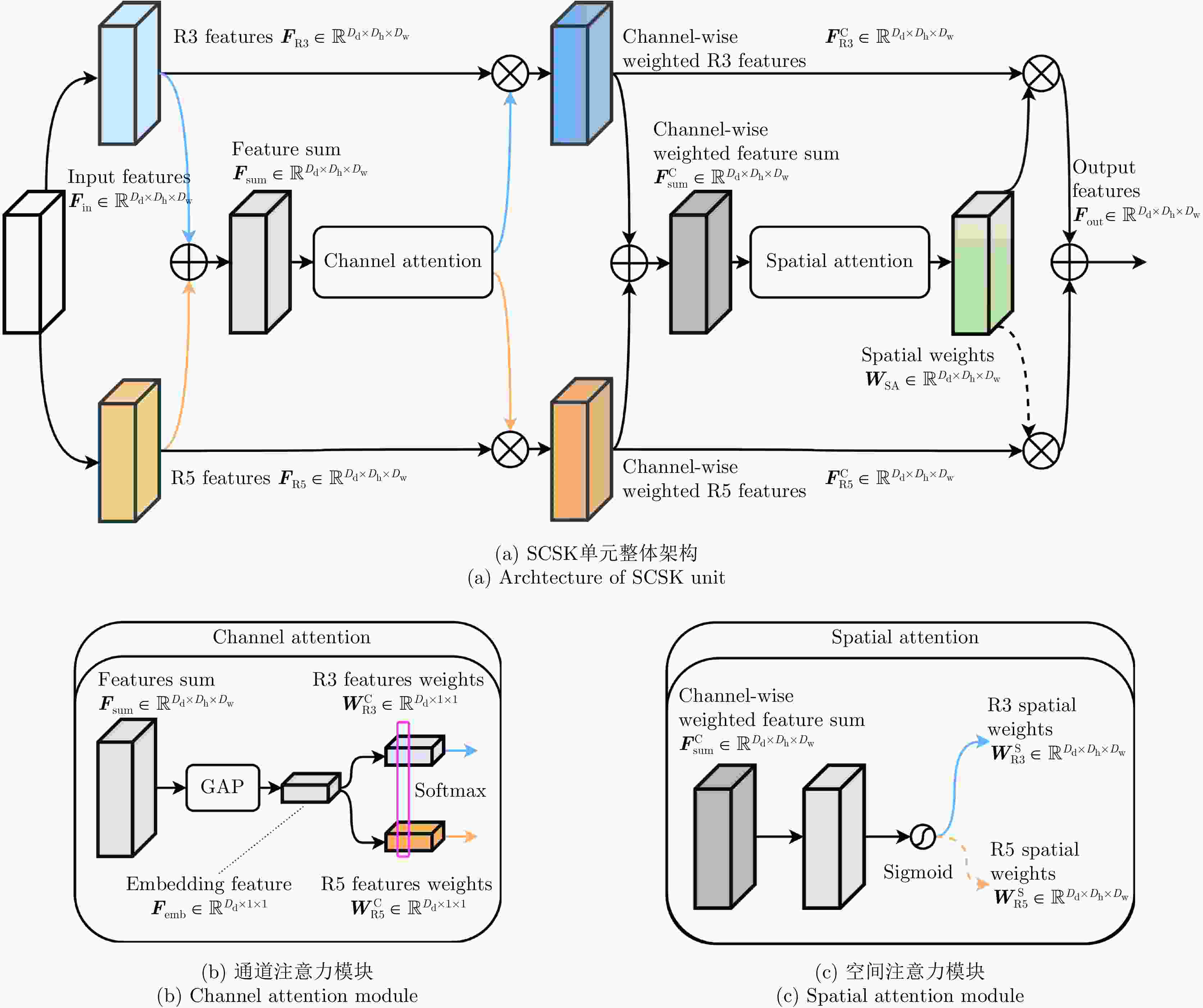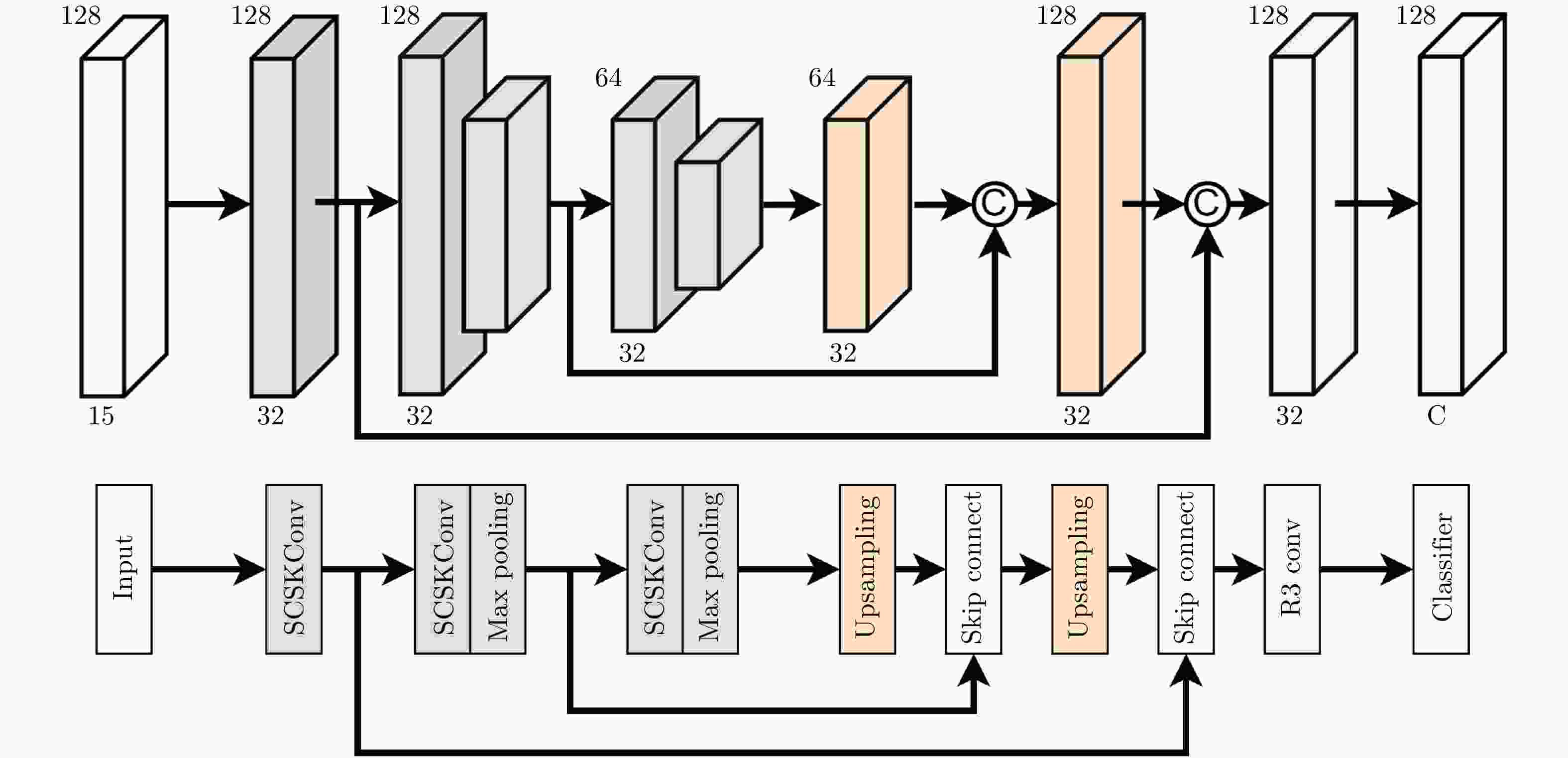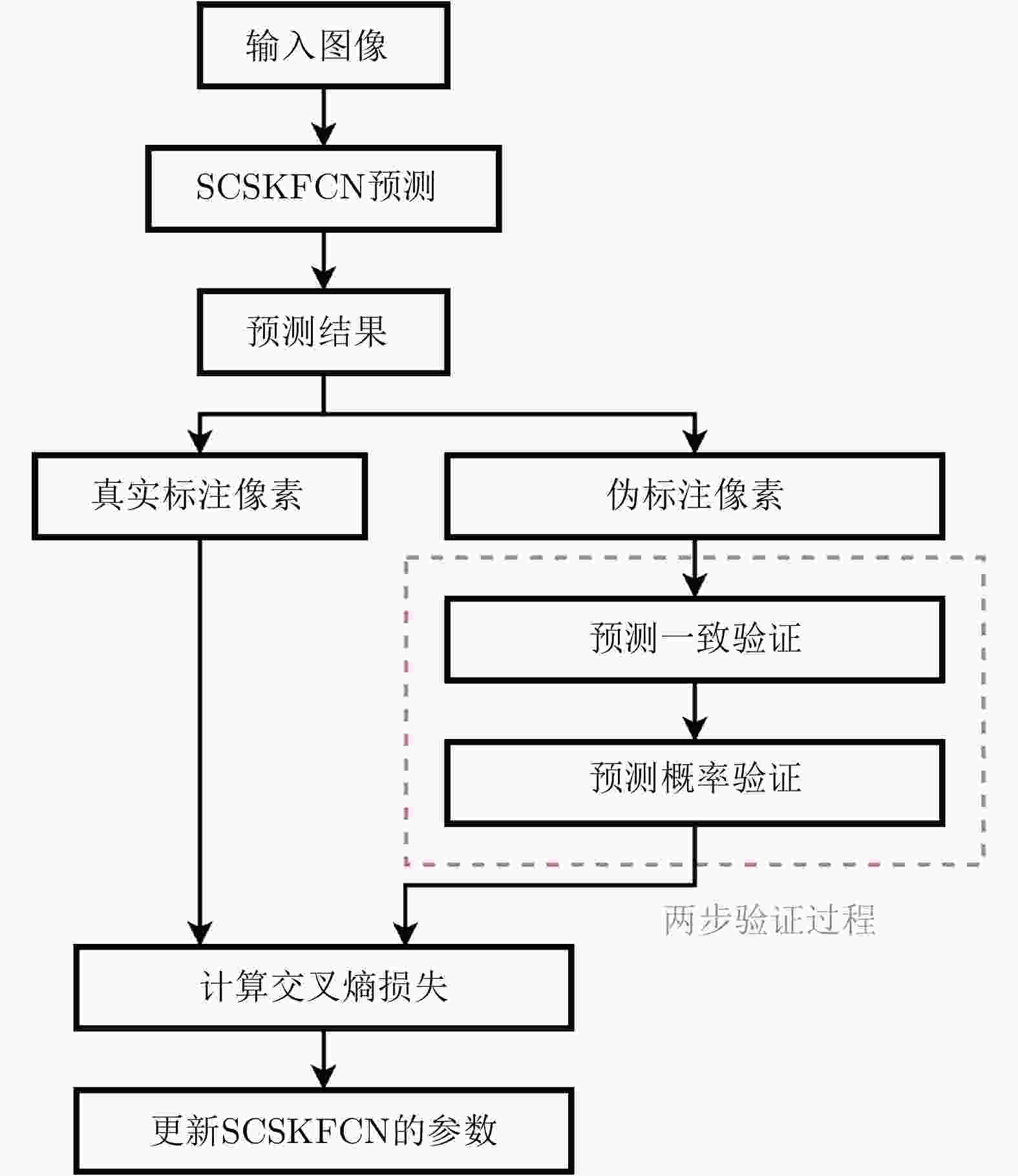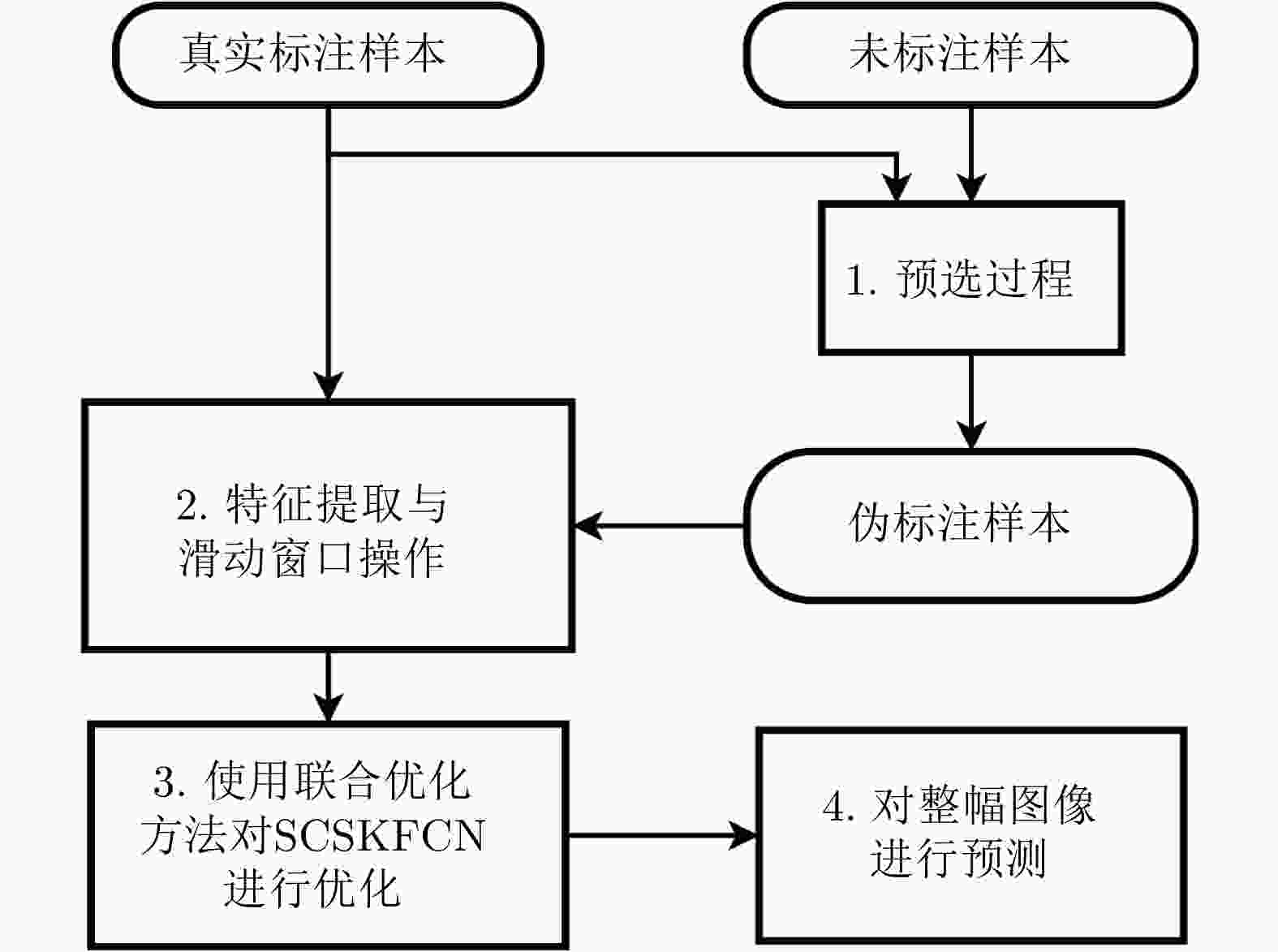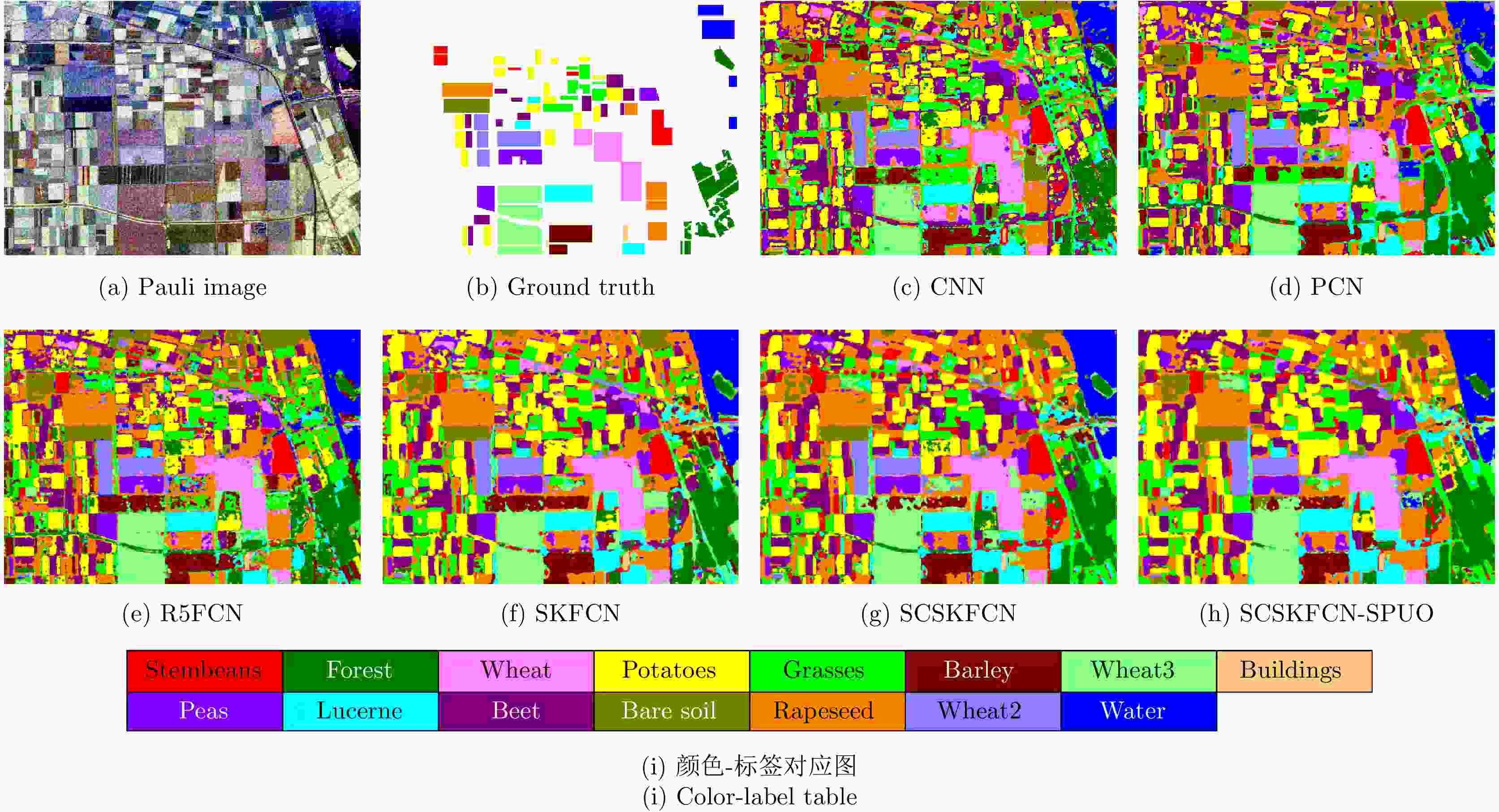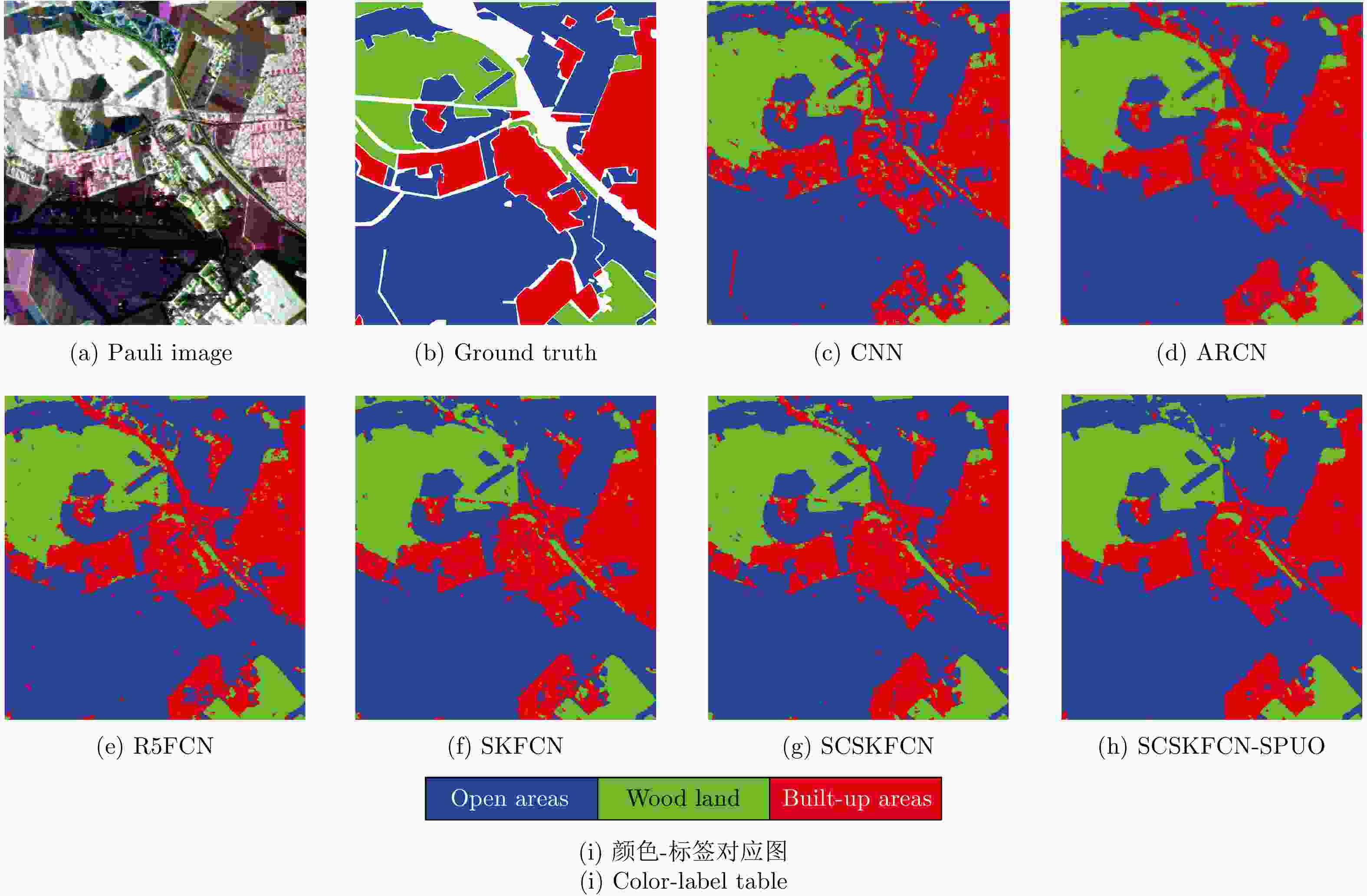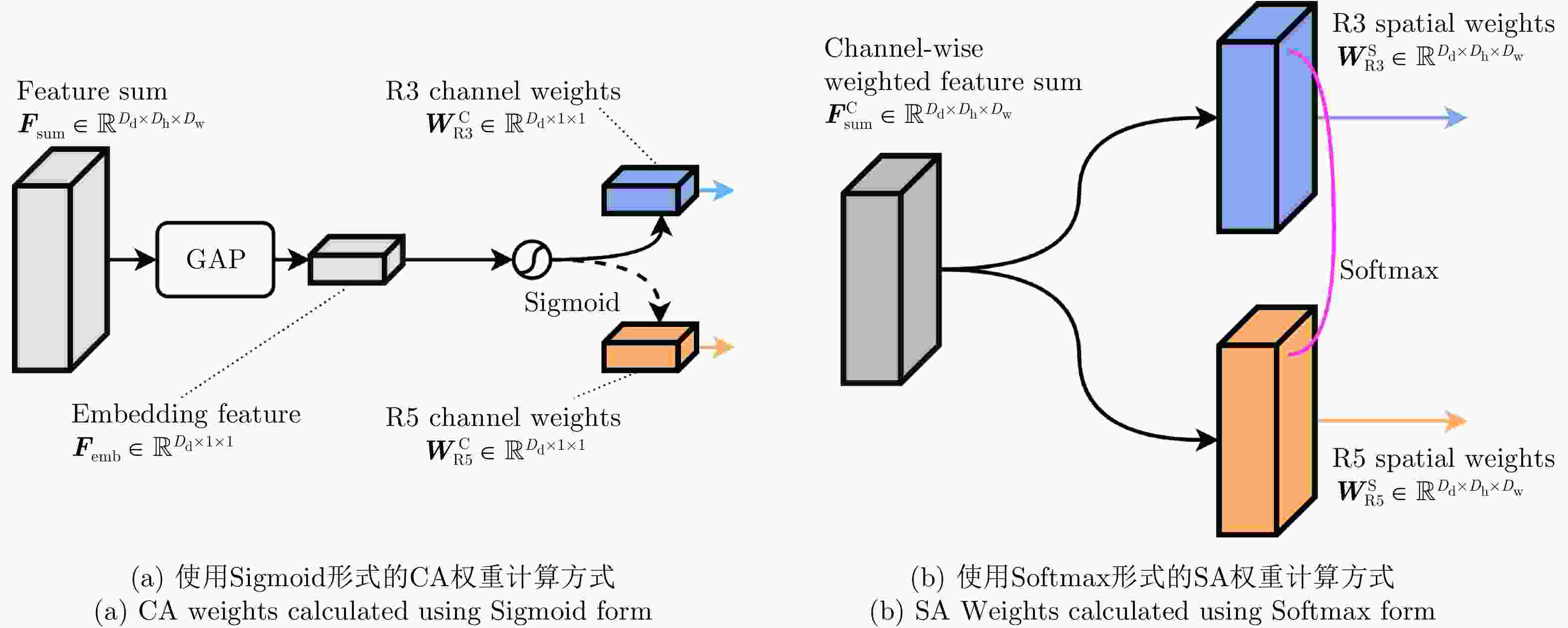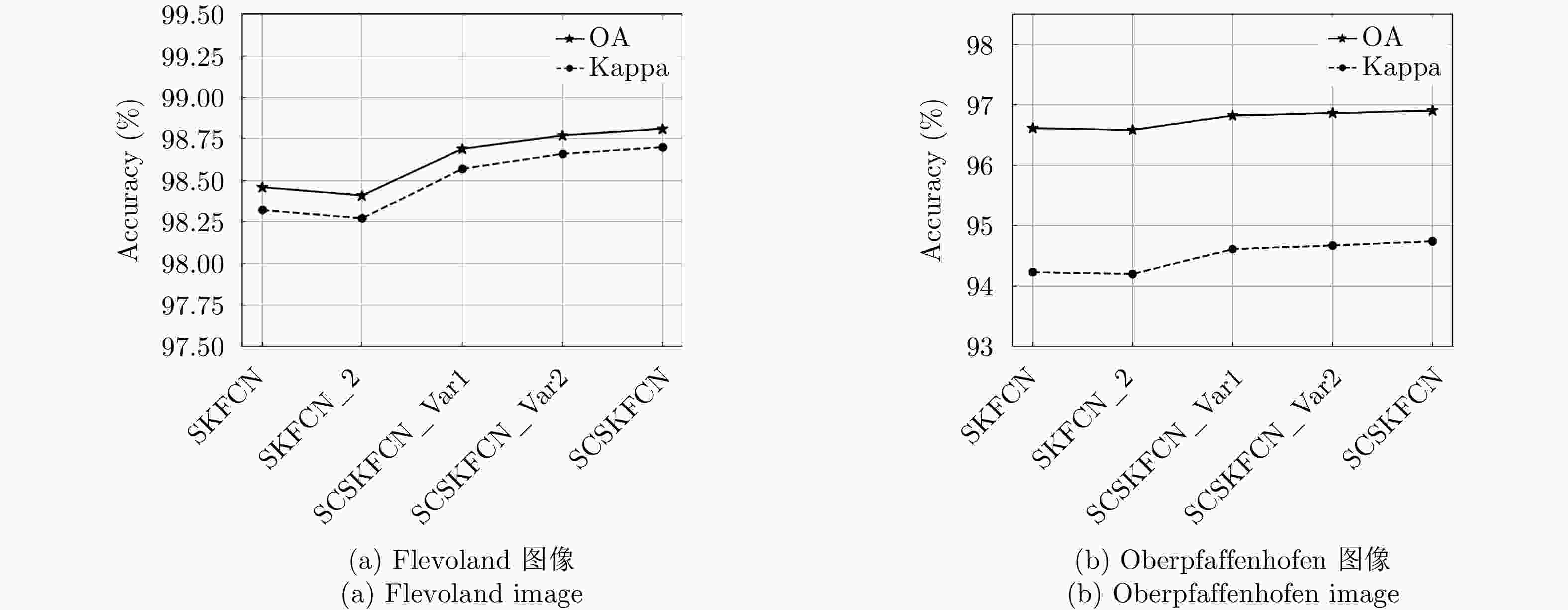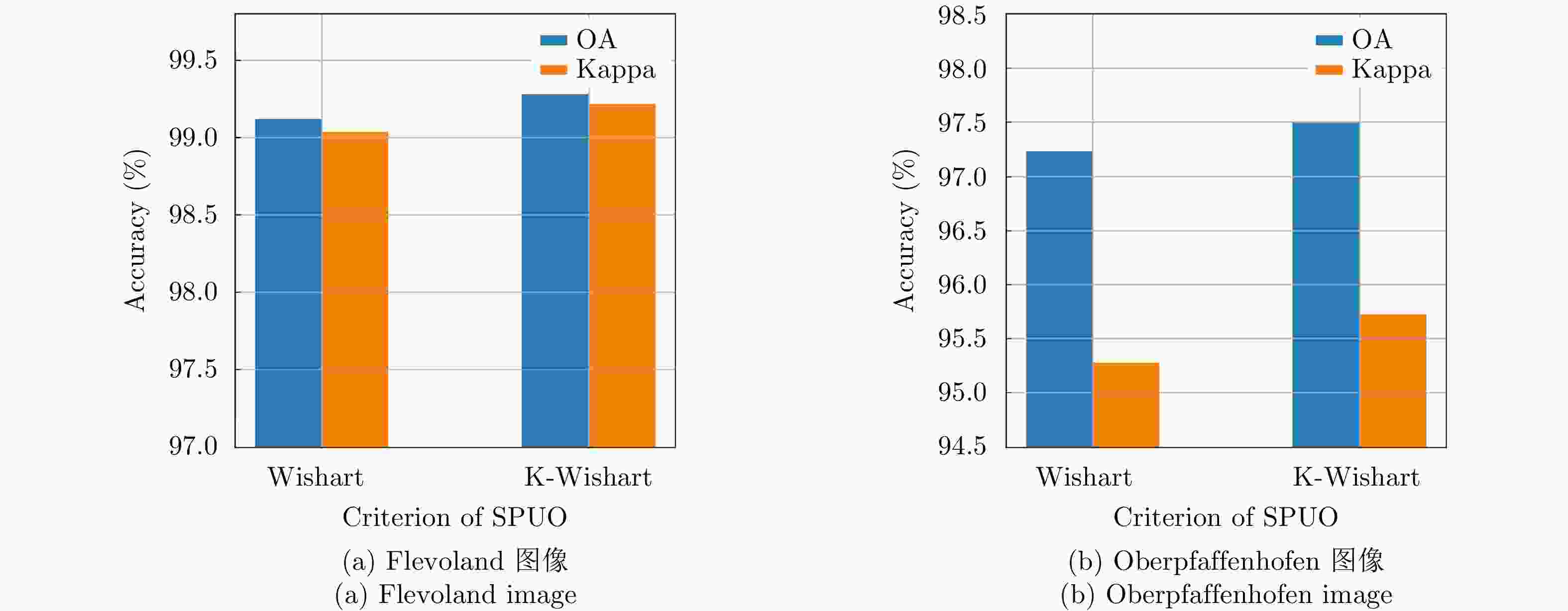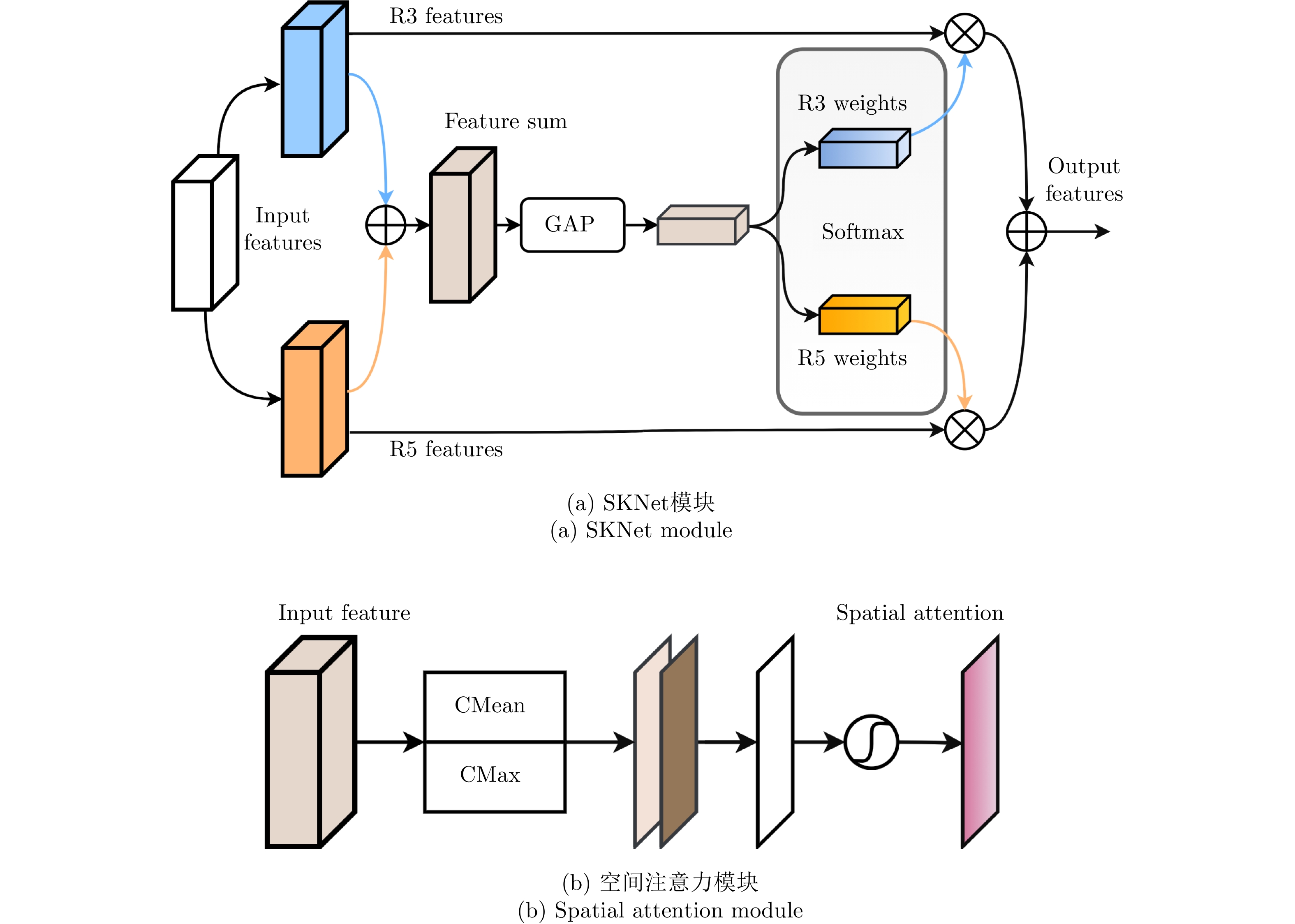Terrain Classification of Polarimetric SAR Images Using Semi-supervised Spatial-channel Selective Kernel Network
-
摘要: 针对极化合成孔径雷达(极化SAR)图像地物分类中标注样本数量少的问题,该文提出一种基于空间-通道选择性卷积核全卷积网络(SCSKFCN)和预选-联合优化半监督学习(SPUO)的极化SAR图像地物分类方法。SCSKFCN通过使用空间和通道注意力机制,对不同感受野的特征进行自适应加权融合,有效提升了模型的分类性能。SPUO能够高效地利用标注样本,挖掘无标注样本中蕴含的信息。它采用K-Wishart距离进行样本预选并生成伪标签,然后在联合优化阶段使用真实标注样本和伪标注样本同时对模型进行优化。在模型优化过程中,SPUO对伪标注样本进行两步验证并筛选可靠的伪标注样本参与优化。实验结果表明,该方法能够在只使用少量标注样本的条件下实现高精度、高效率的极化SAR图像地物分类。
-
关键词:
- 极化SAR图像地物分类 /
- 全卷积网络 /
- 注意力机制 /
- 半监督学习 /
- 空间-通道选择性卷积核网络
Abstract: In this paper, a Spatial-Channel Selective Kernel Fully Convolutional Network (SCSKFCN) and a Semi-supervised Preselection-United Optimization (SPUO) method are proposed for polarimetric Synthetic Aperture Radar (SAR) image classification. Integrated with spatial-channel attention mechanism, SCSKFCN adaptively fuses features that have different sizes of reception field, and achieves promising classification performance. SPUO can efficiently extract information contained in unlabeled samples according to annotated samples. It utilizes K-Wishart distance to preselect unlabeled samples for pseudo label generation, and then optimizes SCSKFCN with both labeled and pseudo labeled samples. During the training process of SCSKFCN, a two-step verification mechanism is applied on pseudo labeled samples to reserve reliable samples for united optimization. The experimental results show that the proposed SCSKFCN-SPUO can achieve promising performance and efficiency using limited number of annotated pixels. -
表 1 Flevoland图像分类结果表(%)
Table 1. Classification accuracy comparison on Flevoland image (%)
Method 1 2 3 4 5 6 7 8 9 10 CNN 99.30 93.36 92.22 91.59 93.56 92.79 95.73 97.93 97.54 98.59 PCN 92.11 95.76 98.71 96.49 91.07 96.27 97.52 96.87 96.13 92.23 R5FCN 99.86 98.32 99.32 96.27 93.03 92.12 96.00 97.45 98.15 98.39 SKFCN 99.89 97.39 99.60 98.55 95.42 97.28 96.81 98.80 97.28 98.98 SCSKFCN 99.96 98.60 99.75 98.74 96.47 97.60 97.73 98.99 97.89 98.79 Proposed 99.98 98.87 99.91 99.44 98.93 98.07 99.03 99.78 97.45 99.17 Method 11 12 13 14 15 OA Kappa Training (s) Test (s) CNN 92.25 96.69 98.84 96.78 65.42 95.19 94.76 247.7 3.1 PCN 96.62 96.32 99.05 98.06 81.26 96.36 96.04 216.8 1.2 R5FCN 97.12 97.68 99.61 99.08 86.12 97.41 97.18 89.3 0.9 SKFCN 99.15 99.08 99.61 99.46 83.77 98.46 98.32 105.6 1.0 SCSKFCN 99.47 99.43 99.64 99.73 82.65 98.80 98.70 112.4 1.1 Proposed 99.56 99.68 99.89 99.50 90.51 99.24 99.18 (19.1)+132.8 1.1 *注:Water(1); Stembeans(2); Forest(3); Potatoes(4); Grasses(5); Beet(6); Rapeseed(7); Peas(8); Lucerne(9); Bare soil(10); Wheat2(11); Wheat1(12); Wheat3(13); Barley(14); Building(15); Proposed表示SCSKFCN-SPUO方法 表 2 Oberpfaffenhofen图像分类结果表(%)
Table 2. Classification accuracy comparison on Oberpfaffenhofen image (%)
Class CNN ARCN R5FCN SKFCN SCSKFCN Proposed Wood land 95.02 96.13 94.97 96.25 96.68 97.18 Open areas 97.17 97.32 97.51 97.76 97.99 98.80 Built-up areas 86.42 93.92 90.47 94.27 94.64 94.86 OA 94.09 96.25 95.27 96.60 96.90 97.51 Kappa 89.88 93.64 91.95 94.23 94.74 95.76 Training (s) 225.9 189.6 120.1 137.2 159.2 (50.3)+173.6 Test (s) 4.6 1.6 1.5 1.7 1.9 1.9 *注:Proposed表示SCSKFCN-SPUO方法 -
[1] LEE J S and POTTIER E. Polarimetric Radar Imaging: From Basics to Applications[M]. Boca Raton, USA, CRC Press, 2017: 1–10. [2] LEE J S, GRUNES M R, AINSWORTH T L, et al. Unsupervised classification using polarimetric decomposition and the complex Wishart classifier[J]. IEEE Transactions on Geoscience and Remote Sensing, 1999, 37(5): 2249–2258. doi: 10.1109/36.789621 [3] WANG Haipeng, XU Feng and JIN Yaqiu. A review of polsar image classification: From polarimetry to deep learning[C]. IEEE International Geoscience and Remote Sensing Symposium, Yokohama, Japan, 2019: 3189–3192. doi: 10.1109/IGARSS.2019.8899902. [4] CLOUDE S R and POTTIER E. An entropy based classification scheme for land applications of polarimetric SAR[J]. IEEE Transactions on Geoscience and Remote Sensing, 1997, 35(1): 68–78. doi: 10.1109/36.551935 [5] FREEMAN A and DURDEN S L. A three-component scattering model for polarimetric SAR data[J]. IEEE Transactions on Geoscience and Remote Sensing, 1998, 36(3): 963–973. doi: 10.1109/36.673687 [6] DEMPSTER A P, LAIRD N M, and RUBIN D B. Maximum likelihood from incomplete data via the EM algorithm[J]. Journal of the Royal Statistical Society: Series B (Methodological) , 1977, 39(1): 1–38. doi: 10.1111/j.2517-6161.1977.tb01600.x [7] FUKUDA S and HIROSAWA H. Support vector machine classification of land cover: Application to polarimetric SAR data[C]. IGARSS 2001. Scanning the Present and Resolving the Future. Proceedings. IEEE 2001 International Geoscience and Remote Sensing Symposium, Sydney, Australia, 2001: 187–189. doi: 10.1109/IGARSS.2001.976097. [8] ZHANG Lamei, SUN Liangjie, and MOON W M. Polarimetric SAR image classification based on contextual sparse representation[C]. IEEE International Geoscience and Remote Sensing Symposium, Milan, Italy, 2015: 1837–1840. doi: 10.1109/IGARSS.2015.7326149. [9] ERSAHIN K, CUMMING I G, and WARD R K. Segmentation and classification of polarimetric SAR data using spectral graph partitioning[J]. IEEE Transactions on Geoscience and Remote Sensing, 2010, 48(1): 164–174. doi: 10.1109/TGRS.2009.2024303 [10] DU Peijun, SAMAT A, WASKE B, et al. Random forest and rotation forest for fully polarized SAR image classification using polarimetric and spatial features[J]. ISPRS Journal of Photogrammetry and Remote Sensing, 2015, 105: 38–53. doi: 10.1016/j.isprsjprs.2015.03.002 [11] LEE J S, GRUNES M R, POTTIER E, et al. Unsupervised terrain classification preserving polarimetric scattering characteristics[J]. IEEE Transactions on Geoscience and Remote Sensing, 2004, 42(4): 722–731. doi: 10.1109/TGRS.2003.819883 [12] LEE J S, SCHULER D L, LANG R H, et al. K-distribution for multi-look processed polarimetric SAR imagery[C]. IEEE International Geoscience and Remote Sensing Symposium, Pasadena, USA, 1994: 2179–2181. doi: 10.1109/IGARSS.1994.399685. [13] DOULGERIS A P, ANFINSEN S N, and ELTOFT T. Classification with a non-Gaussian model for PolSAR data[J]. IEEE Transactions on Geoscience and Remote Sensing, 2008, 46(10): 2999–3009. doi: 10.1109/TGRS.2008.923025 [14] DOULGERIS A P. An automatic U-distribution and Markov random field segmentation algorithm for PolSAR images[J]. IEEE Transactions on Geoscience and Remote Sensing, 2015, 53(4): 1819–1827. doi: 10.1109/TGRS.2014.2349575 [15] LECUN Y, BOTTOU L, BENGIO Y, et al. Gradient-based learning applied to document recognition[J]. Proceedings of the IEEE, 1998, 86(11): 2278–2324. doi: 10.1109/5.726791 [16] SHELHAMER E, LONG J, and DARRELL T. Fully convolutional networks for semantic segmentation[J]. IEEE Transactions on Pattern Analysis and Machine Intelligence, 2017, 39(4): 640–651. doi: 10.1109/TPAMI.2016.2572683 [17] ZHOU Yu, WANG Haipeng, XU Feng, et al. Polarimetric SAR image classification using deep convolutional neural networks[J]. IEEE Geoscience and Remote Sensing Letters, 2016, 13(12): 1935–1939. doi: 10.1109/LGRS.2016.2618840 [18] CHEN Siwei and TAO Chensong. PolSAR image classification using polarimetric-feature-driven deep convolutional neural network[J]. IEEE Geoscience and Remote Sensing Letters, 2018, 15(4): 627–631. doi: 10.1109/LGRS.2018.2799877 [19] CHEN Siwei, LI Yongzhen, DAI Dahai, et al. Uniform polarimetric matrix rotation theory[C]. IEEE International Geoscience and Remote Sensing Symposium, Melbourne, Australia, 2013: 4166–4169. doi: 10.1109/IGARSS.2013.6723751. [20] MOHAMMADIMANESH F, SALEHI B, MAHDIANPARI M, et al. A new fully convolutional neural network for semantic segmentation of polarimetric SAR imagery in complex land cover ecosystem[J]. ISPRS Journal of Photogrammetry and Remote Sensing, 2019, 151: 223–236. doi: 10.1016/j.isprsjprs.2019.03.015 [21] LIU Xu, JIAO Licheng, TANG Xu, et al. Polarimetric convolutional network for PolSAR image classification[J]. IEEE Transactions on Geoscience and Remote Sensing, 2019, 57(5): 3040–3054. doi: 10.1109/TGRS.2018.2879984 [22] LI Yangyang, CHEN Yanqiao, LIU Guangyuan, et al. A novel deep fully convolutional network for PolSAR image classification[J]. Remote Sensing, 2018, 10(12): 1984. doi: 10.3390/rs10121984 [23] CHEN Yanqiao, LI Yangyang, JIAO Licheng, et al. Adversarial reconstruction-classification networks for PolSAR image classification[J]. Remote Sensing, 2019, 11(4): 415. doi: 10.3390/rs11040415 [24] GENG Jie, MA Xiaorui, FAN Jianchao, et al. Semisupervised classification of polarimetric SAR image via superpixel restrained deep neural network[J]. IEEE Geoscience and Remote Sensing Letters, 2018, 15(1): 122–126. doi: 10.1109/LGRS.2017.2777450 [25] BI Haixia, SUN Jian, and XU Zongben. A graph-based semisupervised deep learning model for PolSAR image classification[J]. IEEE Transactions on Geoscience and Remote Sensing, 2019, 57(4): 2116–2132. doi: 10.1109/TGRS.2018.2871504 [26] XIE Wen, MA Gaini, ZHAO Feng, et al. PolSAR image classification via a novel semi-supervised recurrent complex-valued convolution neural network[J]. Neurocomputing, 2020, 388: 255–268. doi: 10.1016/j.neucom.2020.01.020 [27] HUA Wenqiang, WANG Shuang, XIE Wen, et al. Dual-channel convolutional neural network for polarimetric SAR images classification[C]. IEEE International Geoscience and Remote Sensing Symposium, Yokohama, Japan, 2019: 3201–3204. doi: 10.1109/IGARSS.2019.8899103. [28] LI Xiang, WANG Wenhai, HU Xiaolin, et al. Selective kernel networks[C]. IEEE/CVF Conference on Computer Vision and Pattern Recognition (CVPR), Long Beach, USA, 2019: 510–519. doi: 10.1109/CVPR.2019.00060. [29] WOO S, PARK J, LEE J Y, et al. CBAM: Convolutional block attention module[C]. 15th European Conference on Computer Vision-ECCV 2018, Munich, Germany, 2018: 3–19. doi: 10.1007/978-3-030-01234-2_1. [30] PARK J, WOO S, LEE J Y, et al. BAM: Bottleneck attention module[J]. arXiv preprint arXiv: 1807.06514, 2018. [31] XU Bing, WANG Naiyan, CHEN Tianqi, et al. Empirical evaluation of rectified activations in convolutional network[J]. arXiv preprint arXiv: 1505.00853, 2015. [32] MAAS A L, HANNUN A Y, and NG A Y. Rectifier nonlinearities improve neural network acoustic models[C]. The 30th International Conference on Machine Learning, Atlanta, USA, 2013. [33] YU F and KOLTUN V. Multi-scale context aggregation by dilated convolutions[J]. arXiv preprint arXiv: 1511.07122, 2015. [34] HU Jie, SHEN Li, ALBANIE S, et al. Squeeze-and-excitation networks[J]. IEEE Transactions on Pattern Analysis and Machine Intelligence, 2020, 42(8): 2011–2023. doi: 10.1109/TPAMI.2019.2913372 [35] LI Mu. Efficient mini-batch training for stochastic optimization[C]. The 20th ACM Sigkdd International Conference on Knowledge Discovery and Data Mining, Virtual Event, Singapore, 2014: 661–670. -



 作者中心
作者中心 专家审稿
专家审稿 责编办公
责编办公 编辑办公
编辑办公

 下载:
下载:
